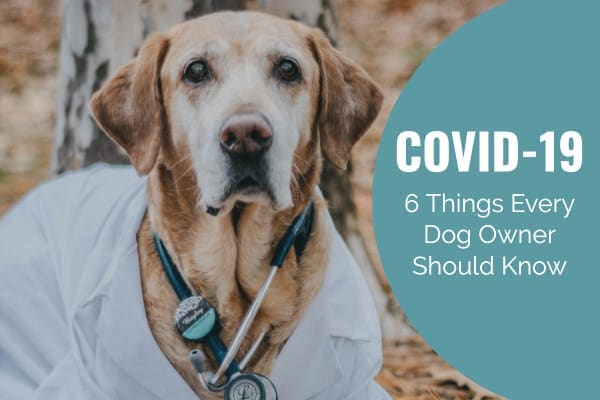
Coronavirus. Dogs. You. Dr. Julie Buzby, integrative veterinarian and founder of Dr. Buzby’s ToeGrips®, shares six steps you can implement right now so that you and your dog are prepped.
Have you ever posted anything on social media and had it “go viral”? Think about the origin of that phrase. We understand it to mean spreading through society like wildfire.
“Corona” is a virus, and it’s doing exactly what viruses love to do—it’s gone viral. But coronavirus seems to be taking the concept of “going viral” to a whole new level because it is a highly contagious, brand-new strain, never before seen by the human race. No one has any natural immunity from previous exposure, there is no treatment, and a vaccine doesn’t yet exist.
It’s not surprising to me that on March 11, the World Health Organization declared COVID-19 a worldwide pandemic.
A brief understanding of the family of viruses called “Coronaviridae”
You may have heard that the “corona” virus is nothing new. It’s true that it’s just the name of a family of viruses: Coronaviridae. Humans get them (like the common cold), and dogs and cats get them too. In fact, your dog may very well have received a vaccine for canine coronavirus as a puppy. The “C” in the vaccination “DAPPC” stands for a coronavirus.
Interestingly, many veterinarians, including myself, don’t vaccinate for this canine strain of coronavirus because it causes a mild, self-limiting illness that doesn’t generally concern us. And this is true of the run-of-the-mill coronaviruses in humans too.
Introducing the all-new, bold, brash, beast-mode coronavirus
Now known as COVID-19 or SARS-CoV-2, this virus is thought to have jumped species from animals to humans. After all, we’re all part of the biological kingdom Animalia, so it’s plausible. Like the previous coronavirus outbreaks SARS and MERS, this coronavirus probably originated as an animal strain, mutated, and became a deadly coronavirus for humans. COVID-19 is thought to have originated in bats. Yes, you read that correctly.
I don’t know where the world is headed with this outbreak, but as a daughter, a mother, and a medical professional, I confess that I’m concerned.

Though I can’t predict the future, I can tell you what I am recommending for my clients. Here are six things that dog owners can do right now to include their dogs in their preparedness plans for coronavirus (COVID-19).
Coronavirus: 6 things that you can do right now for your dog
#1 Keep yourself healthy
This goes back to the concept that flight attendants preach: put the oxygen mask on yourself before you help those around you. This is counterintuitive to a caregiver’s heart, but it makes sense. If you are out of commission, whether it be from hospitalization or just not feeling well enough for your daily walks with your dog, this will have an impact on your dog’s wellbeing.
Out of love for your dog, as well as for fellow humans, please follow the CDC guidelines for keeping yourself as healthy as possible during these tumultuous times. This includes using a good handwashing technique, heeding travel restrictions, practicing responsible social distancing, and using a ton of common sense.
Even with all these preventatives in place, you may be wondering…
If I do get coronavirus, can I infect my dog?
We already know that this disease is zoonotic—meaning it normally exists in animals but can also infect people. For reference, other zoonotic diseases include anthrax, Ebola, and rabies. So, in this case, the key question is the opposite. Can humans infect animals?
You may have seen recent reports about the Pomeranian dog in Hong Kong who tested weak positive for COVID-19 on February 28th. Considering that a dog is really a nose on four legs, it’s not surprising that this dog, whose owner was infected with the virus, had particles in its nostrils and tested positive. At least, that was the original thought.
However, the owner was hospitalized and the dog was placed in quarantine. And at day five and day eight post quarantine, this poor little Pomeranian still tested weak positive. Based on these test results, the conclusion was drawn that the dog was probably actually infected with COVID-19, even though it never showed any clinical symptoms.
UPDATE: Unfortunately, this dog passed away two days after being released from quarantine. When I read this, my heart dropped. But then I read that the dog was 17 years old. So we don’t know the cause of death, but the unknowns in this case crack open Pandora’s box.
Please read my related article, Can Dogs Get Coronavirus? Nitty-Gritty Answers, for in-depth information curated from veterinary experts around the globe and from the CDC (Centers for Disease Control and Prevention.)
What does this mean?
We’re not exactly sure how to interpret the Pom’s story. But the good news is that both the CDC and the World Health Organization (WHO) currently claim there is no evidence to suggest that dogs can get sick from COVID-19, nor are they involved in transmission of the disease to humans. Though we still have much to learn about this novel virus, more and more data suggests that dogs are innocent bystanders.
Experts advise that if you know you are infected, you should ideally avoid contact with your dog. This is a burden too great to bear for most dog owners because it means no petting and snuggling. However, the recommendation comes out of an abundance of caution.
If you do get the coronavirus and you have no other option but to act as the primary caregiver for your pets, the CDC recommends the following:
- thorough hand washing before and after contact with your dog
- wearing a medical face mask while caring for your dog
(We’ll explain why in a minute.)
Should you have any concerns about your dog’s health, I’d recommend that you initially take your dog’s rectal temperature and then contact your veterinarian for instructions. (For more information on monitoring your dog’s body temperature, please read my article: Keeping a Pulse on Your Dog’s Vital Signs.)
Can my veterinarian test my dog for COVID-19?
Interestingly enough, the answer is a qualified “yes.” Recently, I learned that, according to the University of Illinois’ College of Veterinary Medicine website, the university has purchased equipment to run testing for COVID-19 in companion animals. Testing is now available through veterinarians. Should your veterinarian want to know more about this research, he or she can contact the university’s diagnostic laboratory directly at 217-333-1620.
Could my dog be a fomite? Can they transfer the disease?
Fomite. I still remember learning that word in vet school. A fomite is technically an inanimate object (clothing, bedding, etc.) that can transfer germs. The object serves as a way for pathogens to be passed. Of course, your dog is clearly not an inanimate object. However, could they carry particles on their fur which could later infect you? I’m no epidemiologist, but I’m sure the answer is “yes.” And this is the reason why a sick human ideally would not be caring for pets—because they can be turned into four-legged fomites, indirectly transmitting disease (along with your shoes, credit card, and clothing).
I remember learning in vet school that when a horse coughs, particles travel 40 feet. When an infected human coughs or sneezes (or possibly just breathes) particles are aerosolized and land where they will. I suspect that if infectious droplets landed in your dog’s fur, you could contract the virus from petting/cuddling your dog and then touching your own mucous membranes (mouth, nostrils, eyes). Additionally, the newest research is showing that coronaviruses can live on surfaces for “up to several days.” This makes the case for your dog practicing “social distancing” from the outside world too.
#2 Keep a supply of your dog’s food on hand
I do expect that there may be disruptions in our supply chain. As I was loading my groceries on the conveyor belt at Walmart, the cashier surveyed my cart and, finding it void of toilet paper, declared, “I would recommend that you find toilet paper somewhere. Our shelves are empty.” She glanced up as she continued scanning my items and continued, “You know what’s even scarier? We only got one truck today.”
“One truck of toilet paper?” I asked.
“No, one truck period. Only one truck of supplies got delivered.”
“Well, how many do you normally get?” I asked, trying to look at this objectively.
“Two. We always get two.”
As I was saying, I do expect that there may be disruptions in our supply chain. And even though your dog food is (hopefully) not manufactured in China, if there is a disruption anywhere along the line in that supply chain (raw ingredients, packaging materials, labor force, product shipping), supply may be interrupted.

Recently, one of my clients couldn’t get her dog’s prescription dog food. This was unrelated to coronavirus, but it was a major problem because we had to scramble to figure out what to do for this dog. The dog is on a very restrictive diet for a chronic health condition and needs this special food. Period. Plus, even if change were inevitable, the owner realized that changing her dog’s diet abruptly was suboptimal. She needed to have enough of the dog food to be able to make that change gradually. No one likes the feeling of being backed into a corner.
To this end, I recommend having extra dog food on hand—perhaps an extra month’s supply. Also, if home cooking your dog’s food becomes necessary or preferred, I always recommend consulting with a board-certified veterinary nutritionist, such as those listed on KibbleQueen.com. These veterinarians can work with you remotely to provide a balanced, custom diet formulation for your dog. (For more about homecooked diets for your dog, please check out my podcast: Homecooked Diets with Dr. Jackie Parr.)
# 3 Make sure you have your dog’s monthly preventative medications
On a related note, please check your supply of your dog’s heartworm and flea and tick medications. If you haven’t already done so, it is critical that you begin administering flea and tick medication for your pets, especially now that warm weather is upon us.
It’s also critical to continue the use of your monthly heartworm preventative. I’m a huge stickler about the risks associated with stopping heartworm preventative during the “colder months.” Don’t do it. It’s really important to continue year-round. (For the full story on this, please read my article on heartworm disease in dogs.) I could preach this even without a coronavirus outbreak—now is the time to stock up on your dog’s supply of flea, tick, and heartworm preventatives!
#4 Check with your veterinarian about your dog’s prescription medications
According to an article in the New York Times, the majority of the drugs we use today—including antibiotics, topical ointments, and vitamin supplements—come from China. Additionally, the American Veterinary Medical Association recently released a statement expressing concern about potential disruption in the pharmaceutical supply chain.
If your dog—and this is especially important for senior dogs who are more likely to battle chronic disease—is on a medication that they take daily for health issues (ie. seizure medications, thyroid medications, allergy medications), I would strongly recommend that you have an ample supply on hand.
Please don’t wait to refill your pet’s medications. Call your vet now and ask if they are able to provide you a one to three month supply (depending on the medication type and cost). This will be one less thing you’ll have to be concerned about in the coming days.
#5 Ask your vet if they offer telemedicine consults if needed
I suspect that this virus will usher in a new era in veterinary care: telehealth. Of course, this won’t replace standard hands-on care, but we know that it works as a primary screening tool in human medicine and should offer the same benefit for veterinary medicine.
If “social distancing” measures intensify and your pet has a non-urgent health need, call your veterinarian’s office to ask if a “telemedicine” consult is an option. This is essentially a paid “virtual” office visit. Availability will vary by state due to legal red tape. However, this is a great way for pet owners to receive help, advice, and recommendations from their trusted veterinarians without leaving their homes.
#6. Follow the six-foot rule
To prevent the spread of coronavirus, the CDC is advocating “social distancing.” This essentially means giving people lots of personal space and then some. For this reason, conferences, parties, and sporting events have been canceled. People are being encouraged to work from home. We are so blessed to share life with our canine companions who are always faithfully by our side—in sickness and in health.
If you live in an area where you can enjoy walks with your dog while still practicing social distancing—this is a great way to be in communion with another beloved soul and Vitamin D (sunlight). By the way, because there’s a 14-day incubation period for coronavirus, even people who look fine could potentially be carriers. Until further notice, I think it makes good sense to spend less time with John Q. Public and more time with your COVID-19-exempt dog.

Extrapolate what you will from this article for your human family too. Common sense will go a long way in keeping your family and community safe.
Searching for more information on COVID-19 and dogs?
Please read my article, Can Dogs Get Coronavirus? The Nitty Gritty. You’ll find answers from veterinary professionals across the globe along with the CDC’s (Centers for Disease Control and Prevention) official statement.
How are you protecting your dog during the coronavirus outbreak?
Please comment below. We can all learn from each other.


Thank you so much for writing this. I have been wondering and speculating about the reason for not caring for our pets if we are infected with COVID-19. I am going to write my vet right now as my pets run out of heart worm meds next month. Thank you for this vital reminder!!!
Leda, I’m so glad this was helpful to you. Please stay safe and well.
Since I live in NYC where the streets are dirty and gritty, I have started to wash my dogs paws with some mild soap and water whenever we return from a walk outside. The CDC recommends that I wash my hands to prevent the spread of COVID 19 so I want my sweet 18 year old pup, Flag to comply as well. 😉
Brilliant, Patricia. Just make sure to rinse thoroughly. Thanks for sharing this tip.
PS—I love that Flag is 18 years old! Wishing both of you the best of health!
Dr. Busby, this article was awesome! With all the focus on “the virus” and its impact on humans, I don’t think there has been anything out there related to our pets. So, thank you so much for this very helpful and informative article!!
I plan on forwarding this email to as many of my pet-owner friends so they, too, can benefit from your suggestions.
mms
Thanks for your kind word of encouragement, Marlit. My goal is to stay calm, but educated and prepared for both my 2-legged and 4-legged family members’ needs. I’m so happy you found these tips helpful.
Thank you so much for your thoughtful, compassionate information. My 15 year old Lab (Molly) and I Re really glad to get this information!
Thanks so much for your kind words, Peg. They really mean so much to me! Much love to you and Molly.
I truly appreciate your extremely helpful and wise information. Thank you and Casper thanks you!
My pleasure, Cyndi. I am so thankful for you and Casper being faithful readers. Stay safe and well!